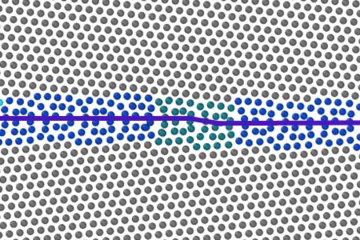All genres
41.
Journal Article
Temperature dependent strain hardening and fracture behavior of TWIP steel. International Journal of Plasticity 104, pp. 80 - 103 (2018)
42.
Journal Article
Constitutive modeling of strain induced grain boundary migration via coupling crystal plasticity and phase-field methods. International Journal of Plasticity 99, pp. 19 - 42 (2017)
43.
Journal Article
Development of a Model for Dynamic Recrystallization Consistent with the Second Derivative Criterion. Materials 10 (11), 1259, pp. 1 - 18 (2017)
44.
Journal Article
Development of damage-resistant dual-phase steels. Chernye Metally 57 (9), pp. 40 - 41 (2017)
45.
Journal Article
Crystal Plasticity Study on Stress and Strain Partitioning in a Measured 3D Dual Phase Steel Microstructure. Physical Mesomechanics 20 (3), pp. 311 - 323 (2017)
46.
Journal Article
Identifying Structure–Property Relationships Through DREAM.3D Representative Volume Elements and DAMASK Crystal Plasticity Simulations: An Integrated Computational Materials Engineering Approach. JOM-Journal of the Minerals Metals & Materials Society 69 (5), pp. 848 - 855 (2017)
47.
Journal Article
Elasto-viscoplastic phase field modelling of anisotropic cleavage fracture. Journal of the Mechanics and Physics of Solids 99, pp. 19 - 34 (2017)
48.
Journal Article
A Flexible and Efficient Output File Format for Grain-Scale Multiphysics Simulations. Integrating Materials and Manufacturing Innovation 6 (1), pp. 83 - 91 (2017)
49.
Journal Article
Coupled Crystal Plasticity–Phase Field Fracture Simulation Study on Damage Evolution Around a Void: Pore Shape Versus Crystallographic Orientation. JOM-Journal of the Minerals Metals & Materials Society 69 (5), pp. 872 - 878 (2017)
50.
Journal Article
Quantenmechanisch geführtes Design von TWIP-Stählen. Stahl und Eisen 137, p. 58 - 58 (2017)
51.
Journal Article
Simulation of thermo-mechanical stresses in Ag/SnO2 materials after arcing events [Simulation thermomechanischer Spannungen in Ag/SnO2-Werkstoffen nach Lichtbogenbelastung]. VDE Fachberichte 73, pp. 114 - 122 (2017)
52.
Journal Article
Entwicklung schadenstoleranter Dualphasenstähle. Stahl und Eisen 137, p. 88 - 88 (2017)
53.
Journal Article
A phase field model for damage in elasto-viscoplastic materials. Computer Methods in Applied Mechanics and Engineering 312, pp. 167 - 185 (2016)
54.
Journal Article
A crystal plasticity model for twinning- and transformation-induced plasticity. Acta Materialia 118, pp. 140 - 151 (2016)
55.
Journal Article
A virtual laboratory using high resolution crystal plasticity simulations to determine the initial yield surface for sheet metal forming operations. International Journal of Plasticity 80, pp. 111 - 138 (2016)
56.
Journal Article
Ab initio-guided design of twinning-induced plasticity steels. MRS Bulletin 41 (4), pp. 320 - 325 (2016)
57.
Journal Article
Unraveling the temperature dependence of the yield strength in single-crystal tungsten using atomistically-informed crystal plasticity calcula- tions. International Journal of Plasticity 78, pp. 242 - 265 (2016)
58.
Journal Article
Neighborhood influences on stress and strain partitioning in dual-phase microstructures. An investigation on synthetic polycrystals with a robust spectral-based numerical method. Meccanica 51 (2), pp. 429 - 441 (2016)
59.
Journal Article
Crystal plasticity study of monocrystalline stochastic honeycombs under in-plane compression. Acta Materialia 103, pp. 796 - 808 (2016)
60.
Journal Article
Recrystallization behavior of a high-manganese steel: Experiments and simulations. Acta Materialia 100, pp. 155 - 168 (2015)










